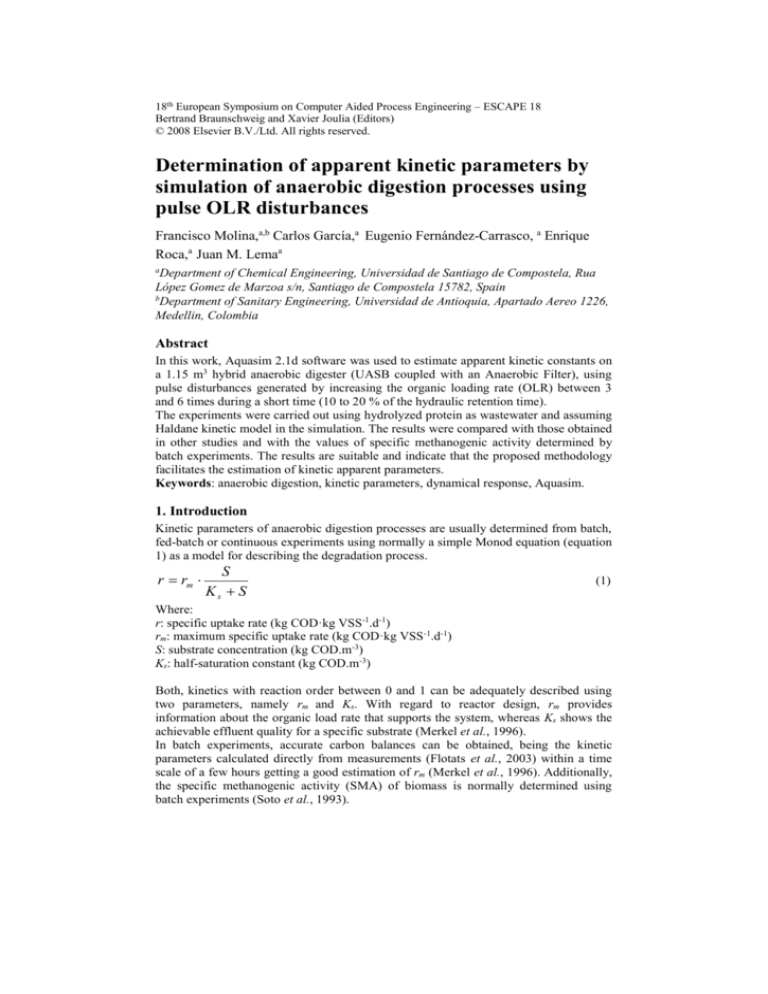
18th European Symposium on Computer Aided Process Engineering – ESCAPE 18
Bertrand Braunschweig and Xavier Joulia (Editors)
© 2008 Elsevier B.V./Ltd. All rights reserved.
Determination of apparent kinetic parameters by
simulation of anaerobic digestion processes using
pulse OLR disturbances
Francisco Molina,a,b Carlos García,a Eugenio Fernández-Carrasco, a Enrique
Roca,a Juan M. Lemaa
a
Department of Chemical Engineering, Universidad de Santiago de Compostela, Rua
López Gomez de Marzoa s/n, Santiago de Compostela 15782, Spain
b
Department of Sanitary Engineering, Universidad de Antioquia, Apartado Aereo 1226,
Medellin, Colombia
Abstract
In this work, Aquasim 2.1d software was used to estimate apparent kinetic constants on
a 1.15 m3 hybrid anaerobic digester (UASB coupled with an Anaerobic Filter), using
pulse disturbances generated by increasing the organic loading rate (OLR) between 3
and 6 times during a short time (10 to 20 % of the hydraulic retention time).
The experiments were carried out using hydrolyzed protein as wastewater and assuming
Haldane kinetic model in the simulation. The results were compared with those obtained
in other studies and with the values of specific methanogenic activity determined by
batch experiments. The results are suitable and indicate that the proposed methodology
facilitates the estimation of kinetic apparent parameters.
Keywords: anaerobic digestion, kinetic parameters, dynamical response, Aquasim.
1. Introduction
Kinetic parameters of anaerobic digestion processes are usually determined from batch,
fed-batch or continuous experiments using normally a simple Monod equation (equation
1) as a model for describing the degradation process.
r rm
S
Ks S
(1)
Where:
r: specific uptake rate (kg COD·kg VSS-1.d-1)
rm: maximum specific uptake rate (kg COD·kg VSS-1.d-1)
S: substrate concentration (kg COD.m-3)
Ks: half-saturation constant (kg COD.m-3)
Both, kinetics with reaction order between 0 and 1 can be adequately described using
two parameters, namely rm and Ks. With regard to reactor design, rm provides
information about the organic load rate that supports the system, whereas Ks shows the
achievable effluent quality for a specific substrate (Merkel et al., 1996).
In batch experiments, accurate carbon balances can be obtained, being the kinetic
parameters calculated directly from measurements (Flotats et al., 2003) within a time
scale of a few hours getting a good estimation of rm (Merkel et al., 1996). Additionally,
the specific methanogenic activity (SMA) of biomass is normally determined using
batch experiments (Soto et al., 1993).
2
Molina F. et al.
However, batch experiments have several drawbacks:
The biomass is usually not adapted to new conditions (Feitkenhauer and Meyer,
2003) and therefore degradation rates can be underestimated.
The estimation of half-saturation constant (KS) is accompanied by high
uncertainty because the low substrate concentrations (where KS is significant)
are frequently achieved only for a short period of time at the end of a batch
experiment (Merkel et al., 1996). Fed-batch option can solve this problem by
feeding substrate at the end of the experiment when there are low concentrations
of substrate.
Nevertheless, in fed-batch experiments the calculation of kinetic constants are based in
the operation of the system under steady-substrate conditions (partial state), which
requires the on-line measurement of biomass and volume of liquid. This is the main
disadvantage of this type of experiments (Romero et al., 2004).
From continuous experiments, kinetic parameters may be obtained by achieving a
certain number of pseudo-steady states where conditions are fixed at each dilution rate
(Diez et al., 1999; Borja et al., 2000). Nevertheless, this approach is a tedious exercise
(Karim et al., 2007) because it requires a long time of experimentation with changes in
the effluent quality, being their application in full-scale reactors quite difficult.
Furthermore, in laboratory reactors, biofilms can be developed on the reactor wall
during the required long periods of operation. At very high dilution rates, degradation
rates may be overestimated because these attached microorganisms are responsible for a
great part of the substrate conversion (Feitkenhauer and Meyer, 2003).
Another approach consists in generating a controlled disturbance and evaluate the
dynamical response in order to estimate kinetic parameters using a process model
(Dominguez et al., 1993) or a mathematical observer based on measurements on line
(Morel et al., 2006). A similar strategy, generating a controlled disturbance in the feed
flow and after watching the response of some key parameters in order to determine
whether or not it is possible to increase the loading rate, has been used for process
control purposes (Steyer et al., 1999).
Through estimation of kinetic parameters the status of biomass and its activity,
specifically the methanogenic activity if the methanogenesis is the limiting step, can be
identified. This study presents results from dynamic estimation of kinetic parameters
associated with anaerobic digestion process. The experiments were carried out on a pilot
plant reactor, using protein based-wastewater and assuming Haldane kinetic model.
Finally, the results have compared with those obtained from other studies and with
values of SMA determined by batch experiments.
2. Materials and methods
In this work, the apparent kinetic constants were estimated in a 1.15 m3 hybrid
anaerobic digester (UASB coupled with an Anaerobic Filter) using hydrolyzed protein
as synthetic wastewater, adding phosphorus and micronutrients. Initially, two pulse
disturbances increasing the organic loading rate (OLR) 3 and 6 times, respectively,
during a short time from 10 to 20 % of the hydraulic retention time (HRT), were used.
Due to the production of biogas during the pulse, a complete mixture regime into the
reactor has been considered. When the reactor operates in pseudo-steady state, the
hydraulics was considered in the model. In this case, residence time distribution (RTD)
experiments have been realized to determine the number of continuous stirred tank
reactors (CSTR) coupled in series. Aquasim 2.1d software (Reichter, 1994) was used to
estimate the apparent kinetic parameters for substrate consumption, studying the
Dynamic determination of apparent kinetic parameters by simulation of anaerobic
digestion processes using pulse OLR disturbances
3
presence of substrate inhibition by used a simple Haldane kinetic model (Equation 2).
Making the adjustment between the variables simulated by the model and the
experimental results obtained with pulse disturbances.
r rm
S
Ks S S
(2)
2
KI
Where:
KI: inhibition constant (kg COD.m-3)
Biomass growth kinetics was neglected due to the high cellular retention time (higher
than 50 days) compared with the HRT. The effect of biomass growth was only
considered in the stoichiometry, assuming that 1 kg of consumed COD produces about
0.35 m3 of methane measured at the outlet reactor conditions. Besides, this software was
also used to make sensitivity analysis for all parameters.
The experiments were conducted at 37 ± 2 ºC. A high recycling flow rate of 200 l·h-1
guaranteed a good mixing into the reactor. The installed on-line measurement devices
included feeding and recycling flow-meters, infrared gas analyzer for measurement
biogas composition and total organic and inorganic carbon (TOC/TIC) analyzer for the
influent and effluent characterization. With this last value, knowing the synthetic
wastewater used, calculation of chemical oxygen demand (COD) was done. A moving
average window of 15 minutes was used for filtering on-line signals, taking into account
the high stability of the signal and the time scale of the process (HRT between 20 and
30 h). Specific methanogenic activity (SMA) has been determined by triplicate using
the methodology proposed by Angelidaki and Sanders (2004).
All simulations were done using Aquasim 2.1d. Only the substrate concentration was
defined as a state variable, being methane flow calculated considering the process
stoichiometry. In a first step, kinetic parameters for a Haldane kinetic model were
estimated used only the pulse experimental points and those in its vicinities. Using
dynamic disturbances the on-line measurement of biomass and liquid volume, which are
the main disadvantages of the kinetic parameter estimations using pseudo-stationary
states, are not required. Due to the effect of the pulse a continuous stirred regime was
considered. Then, using the kinetic parameters previously estimated, a full simulation
along the total time of the experiment was done using two continuous stirred tanks
coupled in series. Hydraulics was determined by the RTD experiments.
3. Results and discussion
For the protein based-wastewater above described, initially estimations of kinetic
parameters were made using the Haldane model. Figures 1 and 2 show the results for
methane flow rate and effluent COD, respectively, for the first pulse where OLR was
three times incremented. As it can be seen in Figure 1, simulated methane flow rate
agree quite well with the experimental methane flow rate during the previous pseudosteady state. During the pulse, the simulated methane flow rate exceeds the methane
flow rate recorded experimentally, due to that the used model assumes that all COD
added has converted to methane. By contrast, Figure 2 shows that there is a good match
between the concentrations of experimental and simulated COD. In this situation was
made the adjustment model given prioritizing the results of the output COD.
4
Molina F. et al.
5
Simulated methane flowrate
Methane flowrate (m 3/d)
4
Experimental methane flowrate
3
2
1
0
0
2
4
6
8
10
12
14
16
18
Time(d)
Figure 1. Comparison between simulated and experimental methane flow rates
1
COD simulated
Effluent COD (kg/m3)
0.8
COD experimental
0.6
0.4
0.2
0
0
2
4
6
8
10
12
14
16
18
Time(d)
Figure 2. Comparison between simulated and experimental effluent COD concentrations
Table 1 presents the comparative between rm of the methanogenic step and SMA for
both pulses studied. The rm values are lower than 1 kg COD·kg VSS-1.d-1, value
reported for Henze and Harremoes (1983) for combined culture during the
methanogenic step. However, the estimated value for rm, is similar to the value found
for SMA of the biomass in both pulses studied. These results indicate that this
methodology can estimate the activity of biomass present in the reactor in an adequate
way.
Dynamic determination of apparent kinetic parameters by simulation of anaerobic
digestion processes using pulse OLR disturbances
5
Table 1. Comparative between rm and SMA for both pulses studied
Pulse
rm (kg COD·kg VSS-1.d-1)
SMA (kg COD·kg VSS-1.d-1)
1
0.56
0.54
2
0.51
0.45
Table 2 shows the estimated values for Ks in both pulses studied including, for
comparison, the range values taken from the literature for methanogenic step. Ks
estimated values are in agreement with values reported in the literature.
Table 2. Ks (kg COD.m-3) values for both pulses studied
Literature values
This study
0.15-0.30
Pulse 1
Pulse 2
0.27
0.78
1
0.03-0.932
1Batstone
2Gujer
et. al., 2002
and Zehnder, 1983
KI estimated values are 4.87 and 2.96 kg COD.m-3, respectively, for the two pulses
studied. The sensitivity analysis for the model parameters showed that the outlet COD
and methane flow were not much sensitive to the variation of the inhibition constant KI.
Besides, the high value of KI indicates that inhibition can be neglected and therefore a
new adjustment was made using a simpler model using only Monod kinetics. For this
case, similar values of kinetic parameters were achieved.
When the amplitude of the pulse increases the value of KI decreases, which indicates
that inhibition assumes importance in the kinetic. An additional pulse, increasing the
OLR 8 times, has been carried out in order to verify this fact. The resulting value of KI
was 0.91 kg COD.m-3 and it was not possible to make the adjustment between
experimental and simulated data using the Haldane model.
4. Conclusions
The present study showed that the estimated kinetic parameters using the strategy of
creating controlled disturbances offers results similar to those obtained by batch tests.
Besides, the use of controlled disturbances requires less time than lab tests and provides
improved information on the status of the process and the activity of biomass.
The amplitude of the pulse used determines the quality of the estimation of kinetic
constants. Therefore, must be used a small amplitude of 3 to 6 times the value of the
initial OLR, in order to avoid the inhibition of process.
The methodology presented is useful and quick for application on industrial wastewater
treatment plants, avoiding severe changes in the quality of the effluent and the
conditions of anaerobic biomass.
Acknowledgment
The authors wish to acknowledge the Spanish National R&D Program and European Regional
Development Fund (ERDF) for the project ANACOM CTQ2004-07811-C02-01.
6
Molina F. et al.
References
Angelidaki, I. and Sanders, W. (2004). Assessment of the anaerobic biodegradability of
macropollutants. Rev. Environ. Sci. Biotechnol., 3, 117–129.
Batstone D.J., Keller J., Angelidaki R., Kalyuzhny S.V., Pavlostathis S.G., Rozzi A., Sanders
W.T.M., Siegrist H. and Vavilin V.A. (2002). Anaerobic Digestion Model Nº 1 (ADM1).
Report Nº13, Task Group for Mathematical Modelling of Anaerobic Digestion Processes.
IWA Publishing, London.
Borja R., Gonzalez E., Raposo F., Millan F. and Martın A (2000). Assessment of kinetic and
macroenergetic parameters for a mesophilic anaerobic fluidised-bed reactor treating
wastewater derived from the production of protein isolates from extracted sunflower flour.
Process Biochemistry, 36, 369–375.
Diez V., Garcia P.A. and Fdz-Polanco F. (1999). Evaluation of methanogenic kinetics in an
anaerobic fluidized bed reactor (AFBR). Process Biochemistry, 34, 213-219.
Dominguez H., Nuñez M.J., Chamy R. And Lema J.M. (1993). Determination of kinetic
parameters of fermentation processes by a continuos unsteady-state method: application to the
alcoholic fermentation of D-Xylose by Pichia stipitis. Biotechnology and Bioengineering,
41(11), 1129-1132.
Feitkenhauer H. and Meyer U. (2003). A new method for the fast determination of kinetic
parameters in anaerobic digestion processes and application to textile wet processing
wastewater. Water Science and Technology, 48(8), 203-210.
Flotats X., Ahring B.K. and Angelidak I. (2003). Parameter Identification of Thermophilic
Anaerobic Degradation of Valerate. Applied Biochemistry and Biotechnology, 109, 47-62.
Gujer W. and Zehnder A.J.B. (1983). Conversion processes in anaerobic digestion. Water Science
and Technology, 15 (8-9), 127-167.
Henze M. and Harremoes P. (1983). Anaerobic treatment of wastewater in fixed film reactors – A
literature review. Water Science and Technology, 15 (8-9), 1-101.
Karim K., Klasson K.T., Drescher S.R., Ridenour W., Borole A.P. and Al-Dahhan M.H. (2007).
Mesophilic digestion kinetics of manure slurry. Applied Biochemistry and Biotechnology,
142, 231-242.
Merkel W., Schwarz A., Fritz S., Reuss M. and Krauth K. (1996). New strategies for estimating
kinetic parameters in anaerobic wastewater treatment plants. Water Science and Technology,
34 (5-6), 393-401.
Morel E., Tartakovsky B., Guiot S.R. and Perrier M. (2006). On-line estimation of kinetic
parameters in anaerobic digestion using observer-based estimators and multiwavelength
fluorometry. Water Science and Technology, 53 (4-5), 77-83.
Reichert P. (1994). AQUASIM - A tool for simulation and data analysis of aquatic systems.
Water Science and Technology, 30(2), 21-30.
Romero J.A., Navarro J.L. and Pico E. Fedbatch experiments with substrate stabilization for the
identification of kinetic models in stirred-tank bioreactors. In: Proceedings 9th International
Symposium on Computer Applications in Biotechnology, CAB9, Nancy (France) March 2831, 2004.
Soto M., Mendez R. and Lema J.M. (1993). Methanogenic and non-methanogenic activity tests.
theoretical basis and experimental set up. Water Research, 27 (8), 1361-1376.
Steyer J.P., Buffieere P., Rolland D. and Moletta R. (1999). Advanced control of anaerobic
digestion processes through disturbances monitoring. Water Research, 33(9), 2059-2068.









